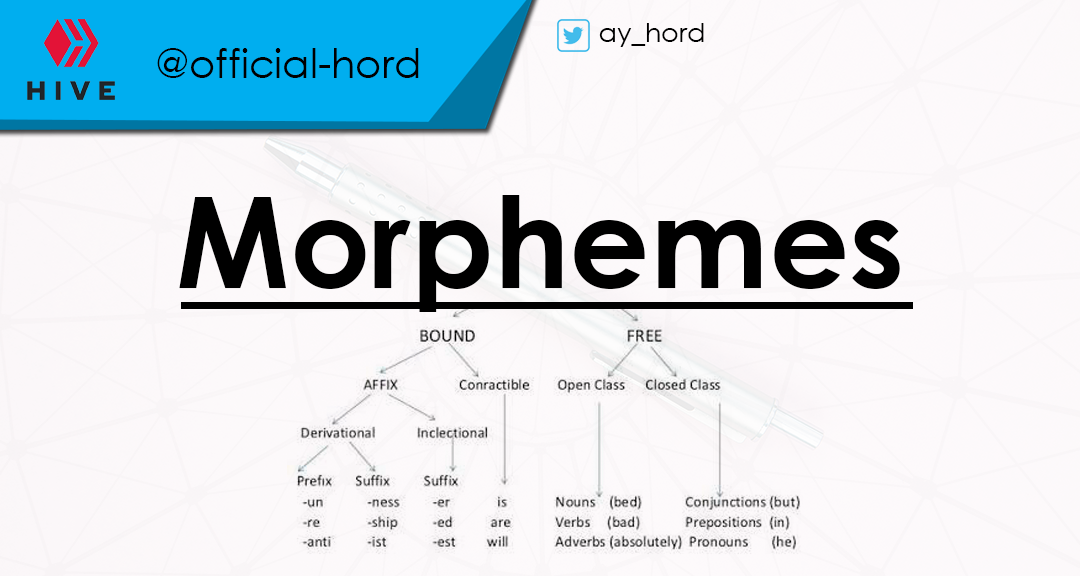Subject: English Language
Topic: Morphemes

Teaching Aids/ Instructional Materials: The use of textbooks, dictionary, and learning mats.
Behavioral Objectives: At the end of the lesson, students should be able to:
1. Define Morphemes explicitly
2. Explain the parts of morphemes. i.e root words, affixation.
Introduction:
The teacher introduces the lesson by asking what the term 'morpheme'?
STEP 1:
A morpheme can be defined as the smallest or minimal meaningful unit in a language. Morpheme may also be defined as the smallest in the grammar rank scale. We all know following the grammar rank scale system, a morpheme is the first and smallest. This implies that every part of morpheme has a meaning, either grammatical or semantical.
It is different from word in the sense that, A WORD can stand on its own with a meaning, Morpheme also can stand on its own with meaning in some cases but not all. Where a word no matter how small it is must carry a semantic meaning according to its definition.
What is a grammatical and a semantical function?
A grammatical function is a functional role between parts in a clause or sentence. Part of a clause of a sentence may include-viz. Subject, Verb, Object(direct or indirect).
Semantic deals with the meaning of words. This helps the reader to comprehend the message being passed across intensively through the interpretation of each word. However, a morpheme might not have a semantic function in a word, phrase, or clause, especially in a bound morpheme. Note, that a morpheme should carry a semantic meaning related to its root word.
Most students of English language also mistake morpheme for a syllable. While morpheme, is a smallest or minimal meaningful unit of a language, a syllable is the phonological break down of words segmentally. This connotes that morphemes deal with breaking down of words but syllable deals with breaking down of sounds. Syllable deals with phonetics or sounds, the properties of those segmented sounds in a words. We might have a syllabic sound(monosyllable), di-syllable, tri-syllable, or even poly syllable depending on the segmented sounds in a word.
Another difference between a morpheme and a Syllable is that while a morpheme has a meaning irrespective of its minimal unit, a syllable does not have any meaning either grammatically or semantically. A syllable is just a sound without a meaning, but morphemes are units with meaning. Let make an illustration below.
In the word PHONOLOGICAL. We would find out that there are five segmented sounds in that word. Which could be broken as PHO-NO-LO-GI-CAL Thus, we can say that the word PHONOLOGICAL is a poly-syllabic word(three-syllable word). In each of the syllables, we discover that they are meaningless both grammatically and semantically. i.e, What is the meaning of PHO?
Another example of a syllable is BISCUIT. The word here has 2 syllables and can otherwise be called Di-syllabic word. It could be broken as BIS-CUIT.
However, in morpheme, the word PHONOLOGICAL, has TWO MORPHEMES. We are not going to break this in sounds instead, we are breaking it into its morphemic unit. Thus, it could be broken as PHONOLOGY- CAL. In this case, we have two morphemes here because each unit has meaning, either grammatically or semantically. The first one is PHONOLOGY which can be said as the ROOT WORD and it has a lexical meaning. Phonology is the study of the way sound functions in a language. Phonology is a noun but when the other morpheme which is an affix is added, it becomes PHONOLOGICAL. Phonological here has changed the word class of the root word from noun to an adjective. We shall discuss the root words and affixes below in our lesson.
The second example is BISCUIT. The word biscuit is a mono morphemic word, meaning it has just a morpheme. This is because we really can't break this word again into another meaningful word to get a root word. We can't say BIS-CUIT because it makes no sense, the only morpheme or smaller unit we could break it into is BISCUIT. The word biscuit is a lexical word and has semantic meaning. It could perform the function of a noun or an adjective. Note, a morpheme must be meaningful and should have the ability to perform some certain grammatical functions.
STEP 2:
Root Word: A root word also called the base word in morpheme is a primary lexical unit of a word, which carries the most significant aspect of semantic content and cannot be reduced into smaller units. This means that the root word is the main lexical word(can stand on its own ) then be derived from the entire word.
A root word is what all the affixes in that word talk about. This means that every additional word to the base word must tally semantically with the base or root word. i.e, UNDERSTANDABLE. We can derive two morphemes from this word which is UNDERSTAND-ABLE. Understand is the root word because the word, in general, revolves around it. ABLE here can be said to be a suffix that is placed at the end of the root word to modify the meaning. UNDERSTAND is a verb but when the suffix was added UNDERSTANDABLE becomes an adjective.
The root word has a meaning on its own, but the affix added, compliment, or modify the root word to make it fit for some clauses or sentences.
AFFIXATION
Affixes: These are words added to morphemes either before the root word or after the root word to modify such words. In some cases, if an affix is added to a root word, the initial part of speech or word class changes. This is because most affixes are used to modify or add meaning to a root word. There are two types of Affix which are PREFIX and SUFFIX. Affixes are used called BOUND MORPHEMES. Examples of affixes are PREmature, REorientate, departmentalIZE, beautifulLY, playING, e.t.c
TYPES OF AFFIXATION
Prefix(es): These are words added before a root word or morpheme. They are usually placed before a word to add meaning or modify the words or meanings. Examples, MISunderstand, REgenerate, PREnursery, PREdetermined, MISlead. Prefixes, just as these examples entail, are those words added to the main word to modify it.
Prefixes might turn a word to the opposite of the actual word. e.g, MISunderstand: the root word here is UNDERSTAND it means to be aware of something or meaning of something, but when you add the prefix (MIS) it gives the exact opposite of understanding. Another example is REorientate. The root word is ORIENTATE which means to determine one's position relative to the surrounding, but when the prefix is added (RE) it add more meaning to the root word which means to orientate in another way.
Suffix(es): These are words also added to root words, but the difference is that suffixes are added after the root words. Unlike the prefix that is before or at the beginning of the root word, suffixes are found after the root of the words. They are also used to modify the meaning of the root words. Examples of suffixes are, readABLE, departmentAL, correcTION, etc. Suffix modifies a root word. i.e, playING, the root word is PLAY which is to act in a manner such that, one has fun.
When the suffix (FUL) is added, it modifies the meaning. PLAYFUL semantically becomes the act of playing frequently or more often. Hence, the meaning of the root word has been modified by the suffix. Note, the root word (play) is a verb, but when the suffix was added, it became (playful) an ADVERB. So this implies that in some cases, affixation generally, changes the word class (part of speech) of the root word. We shall continue on the types of morphemes in our next lesson.

Assignment
- Explain in your own words the term 'morpheme'.
- Try listing 7 words with affixations.
